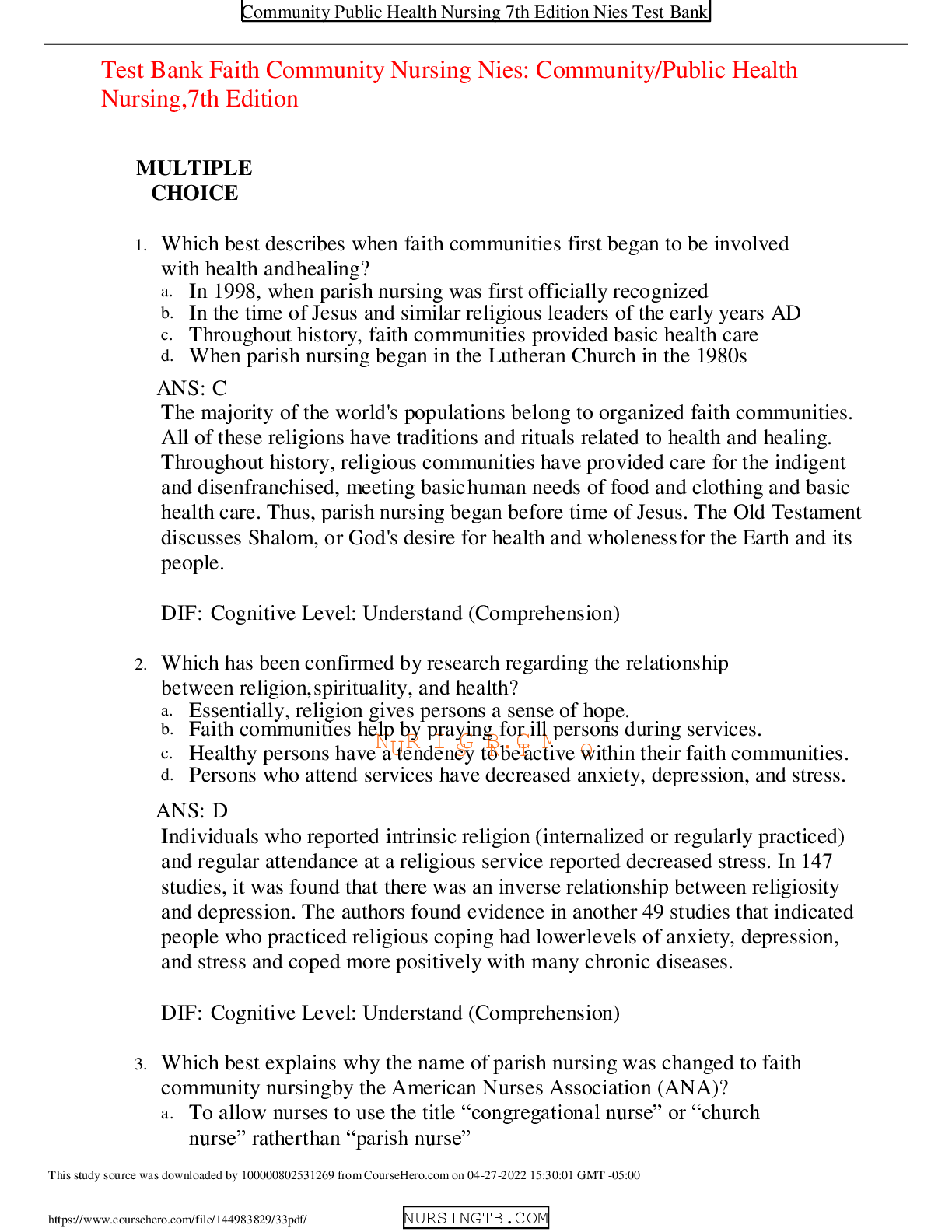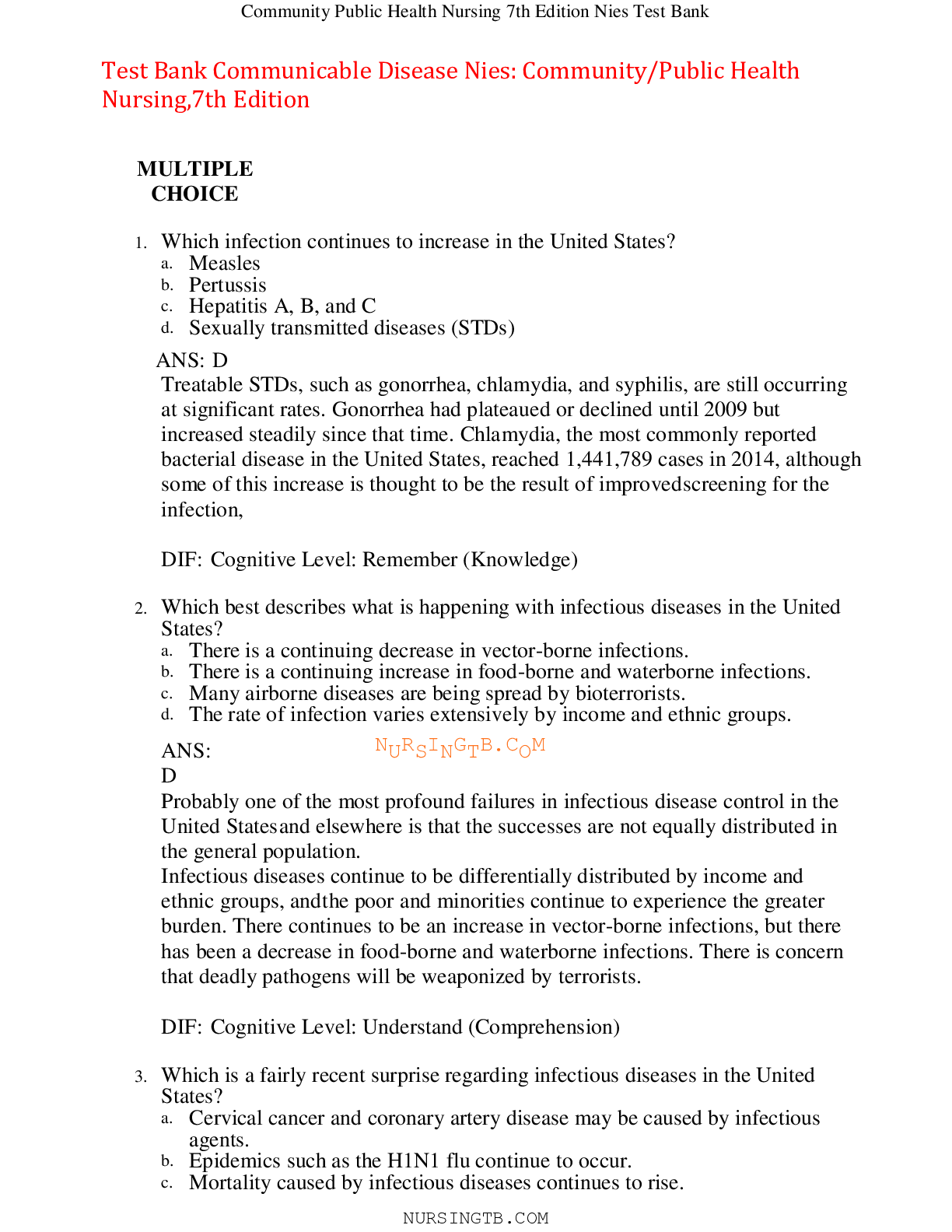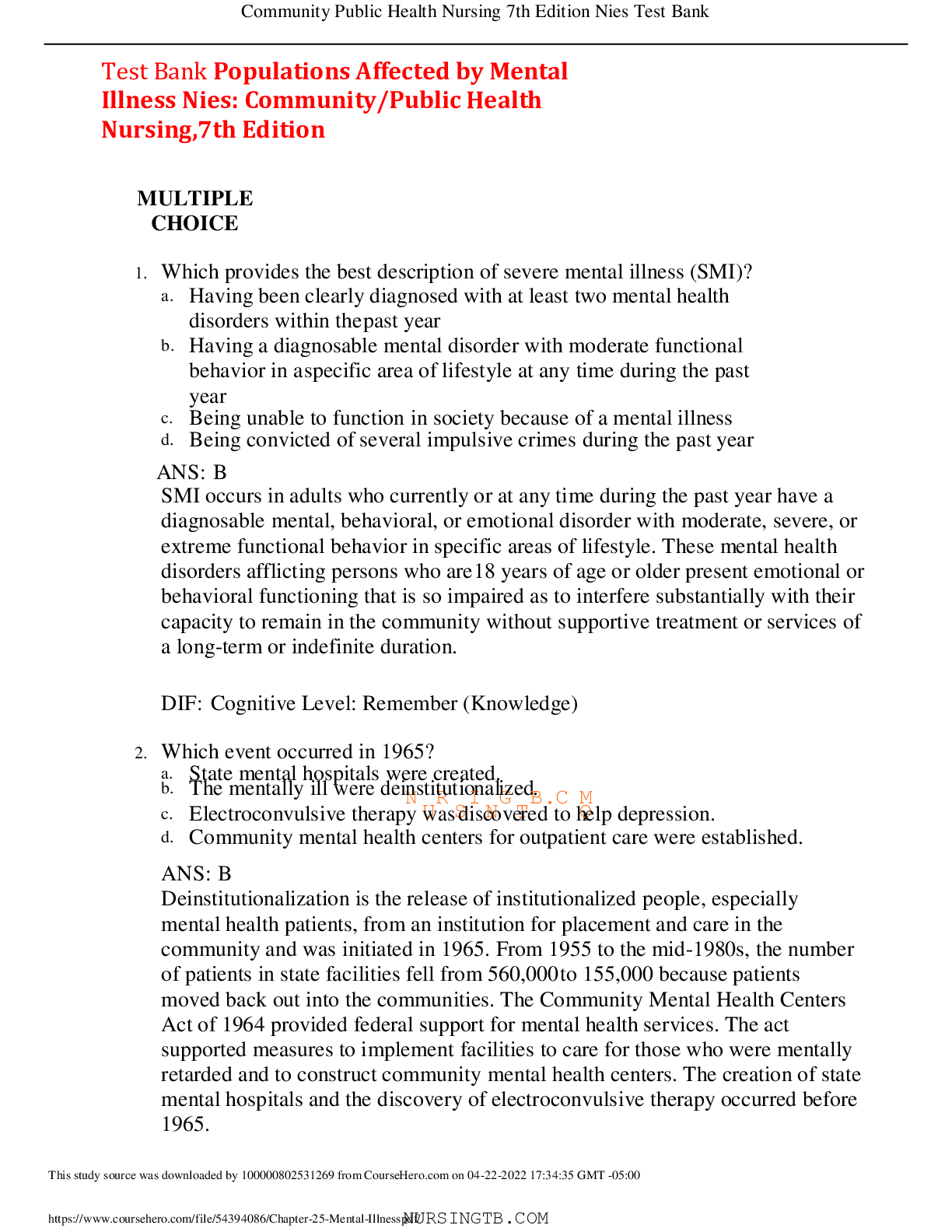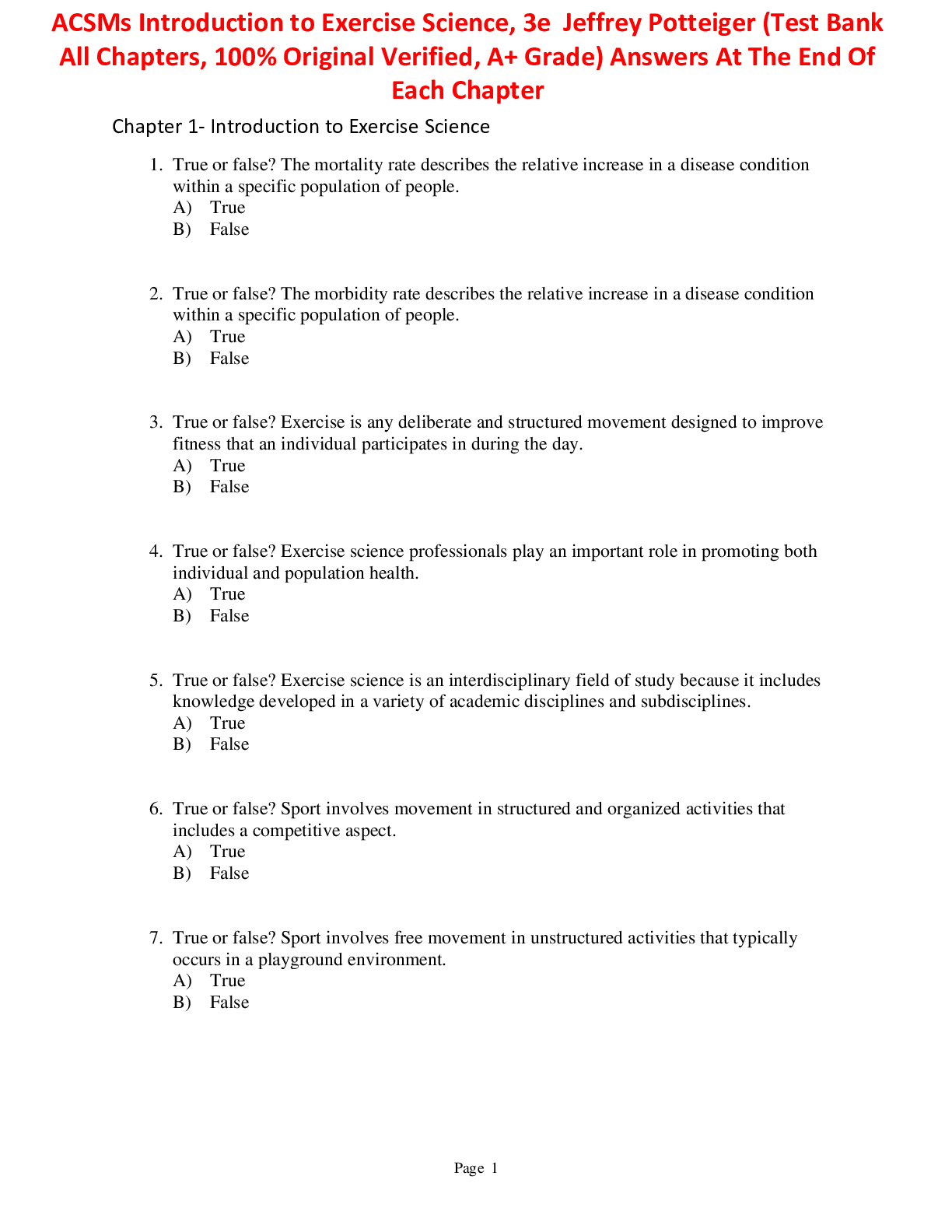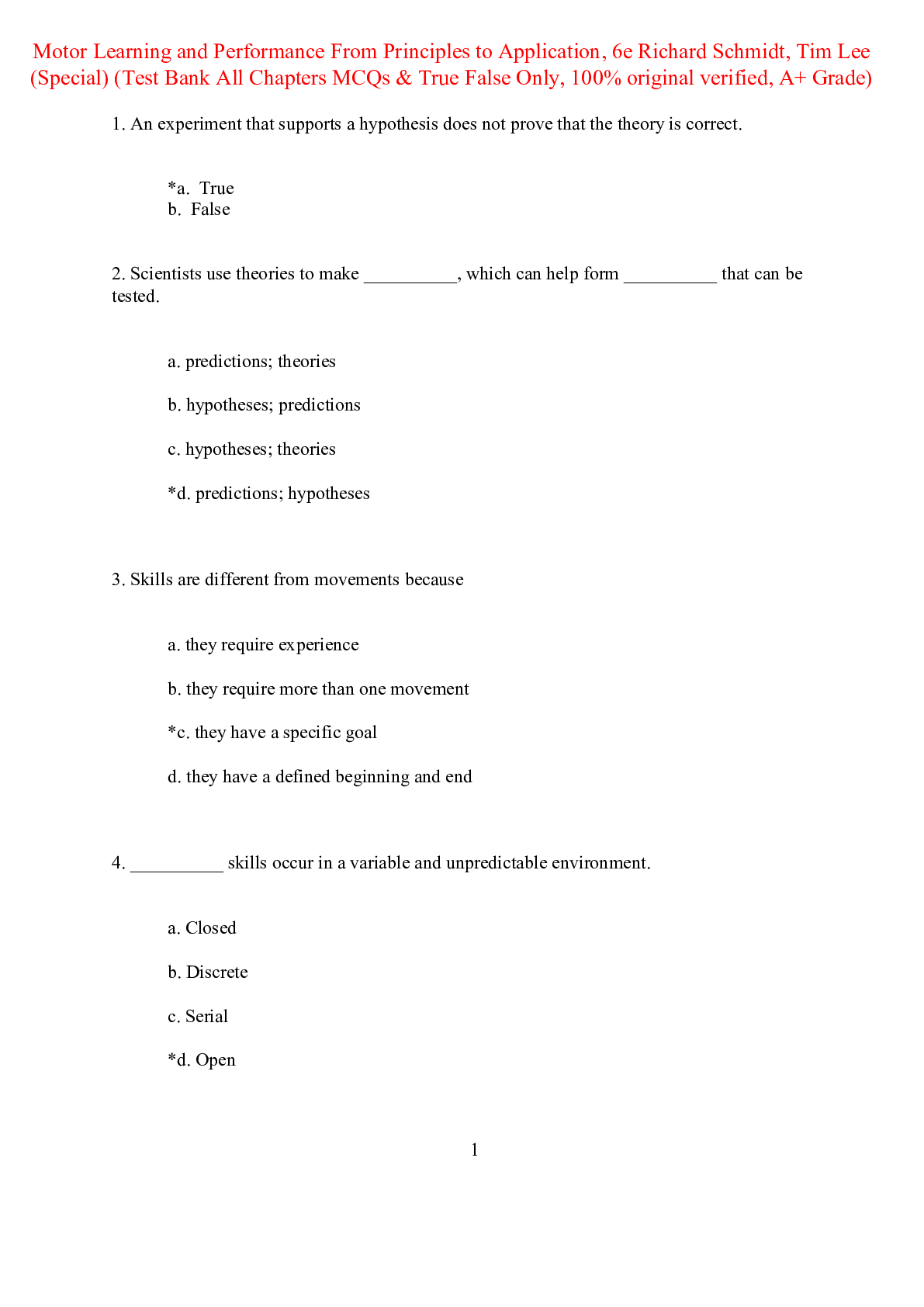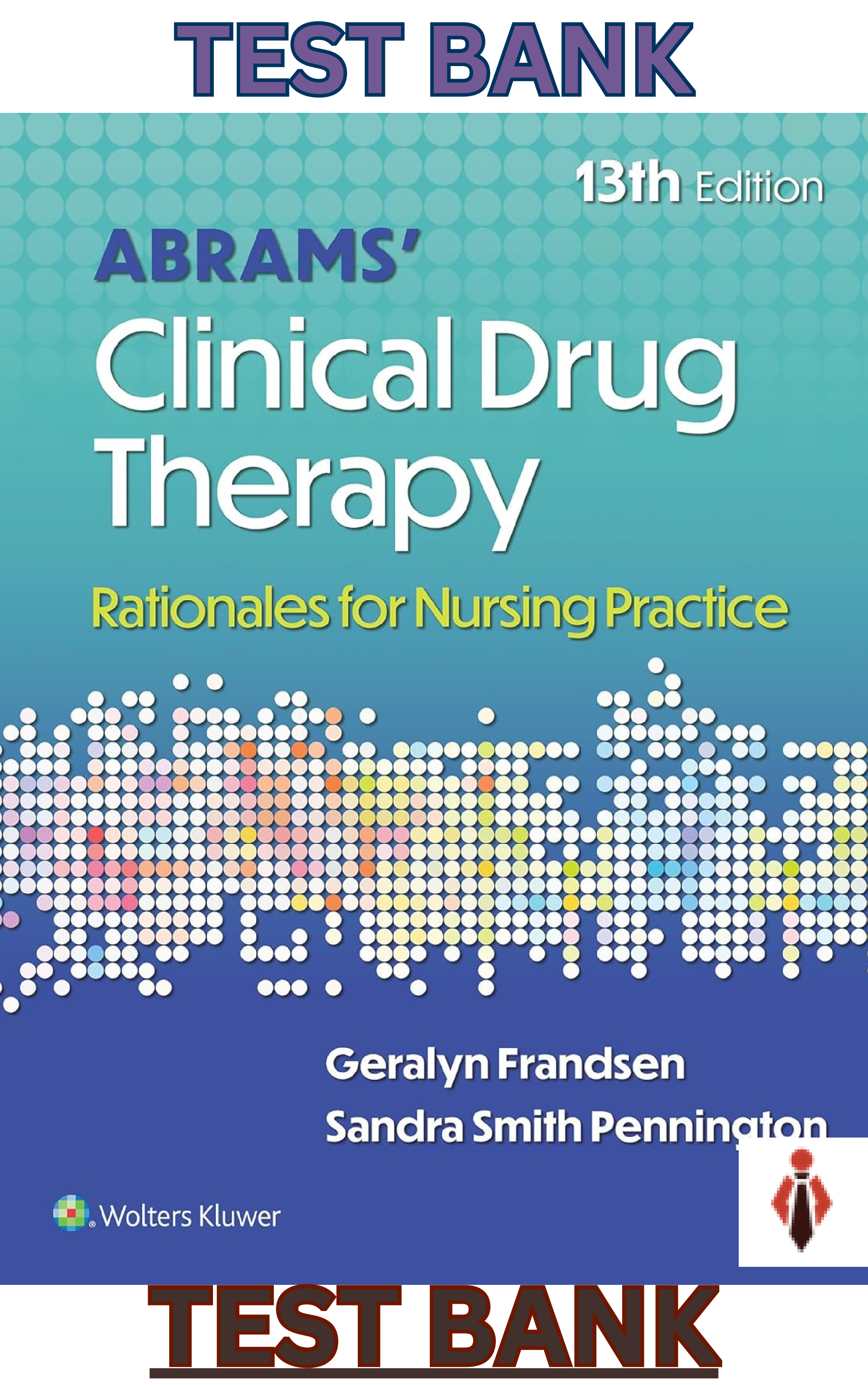*NURSING > TEST BANK > Test Bank Populations Affected by Mental Illness Nies: Community/Public Health Nursing,7th Edition,1 (All)
Test Bank Populations Affected by Mental Illness Nies: Community/Public Health Nursing,7th Edition,100% CORRECT
Document Content and Description Below
Test Bank Populations Affected by Mental Illness Nies: Community/Public Health Nursing,7th Edition MULTIPLE CHOICE 1. Which provides the best description of severe mental illness (SMI)? a. Ha... ving been clearly diagnosed with at least two mental health disorders within the past year b. Having a diagnosable mental disorder with moderate functional behavior in a specific area of lifestyle at any time during the past year c. Being unable to function in society because of a mental illness d. Being convicted of several impulsive crimes during the past year ANS: B SMI occurs in adults who currently or at any time during the past year have a diagnosable mental, behavioral, or emotional disorder with moderate, severe, or extreme functional behavior in specific areas of lifestyle. These mental health disorders afflicting persons who are 18 years of age or older present emotional or behavioral functioning that is so impaired as to interfere substantially with their capacity to remain in the community without supportive treatment or services of a long-term or indefinite duration. DIF: Cognitive Level: Remember (Knowledge) 2. Which event occurred in 1965? a. State mental hospitals were created. b. The mentally ill were deiNnstiRtutioInalGizedB. .C M c. Electroconvulsive therapy UwasSdiscNoveTred to hOelp depression. d. Community mental health centers for outpatient care were established. ANS: B Deinstitutionalization is the release of institutionalized people, especially mental health patients, from an institution for placement and care in the community and was initiated in 1965. From 1955 to the mid-1980s, the number of patients in state facilities fell from 560,000 to 155,000 because patients moved back out into the communities. The Community Mental Health Centers Act of 1964 provided federal support for mental health services. The act supported measures to implement facilities to care for those who were mentally retarded and to construct community mental health centers. The creation of state mental hospitals and the discovery of electroconvulsive therapy occurred before 1965. DIF: Cognitive Level: Remember (Knowledge) 3. Which best describes how brain imaging scans are being used? a. To deliver electroconvulsive therapy to high-risk individuals b. To help detect and diagnose medical disorders and illnesses c. To help determine treatment options for mental disorders d. To help determine the effects of psychotherapy ANS: B Brain imaging scans, also called neuroimaging scans, are being used more and more to help detect and diagnose a number of medical disorders and illnesses. Currently, the main use of brain scans for mental disorders is in research studies to learn more about the disorders. These researchers study healthy brain development, effects of mental illnesses, or effects of mental health treatments on the brain. Brain neuroimaging helps researchers study healthy brain development, effects of mental illnesses, or effects of mental health treatments on the brain. DIF: Cognitive Level: Remember (Knowledge) 4. Which best describes how people with mental illness are viewed by the general public? a. Individuals in need of assistance b. Criminals who need to be institutionalized c. Lazy, weak, and immoral d. Contributing members of society ANS: C Throughout history, the symptoms of mental illness have been perceived as permanent, dangerous, frightening, and shameful. People with a diagnosis of mental illness have been described as lazy, idle, weak, immoral, irrational, and, too often, criminal. DIF: Cognitive Level: Understand (Comprehension) 5. Which would be most upsetting for American families when their loved one, after serving in Iraq or some other battlefield, returns home? a. Many families, especially those with children, do not want guns in the house. b. Reabsorbing them into the family structure is challenging and difficult. c. The suicide rate is twice as high as among nonveteran adults. d. They must use the VeteranUs AfSfairNs mTedical sOystem for medical care. ANS: C Male veterans in communities are twice as likely to die by suicide as their civilian counterparts. There is nothing to support that these veterans will have guns in their homes. The veterans will be able to use the Veteran Affairs system for medical care and there may be challenges with their return home, but that should not be as upsetting as the risk for suicide for their loved one. DIF: Cognitive Level: Understand (Comprehension) 6. Which was required by the Paul Wellstone and Pete Domenici Mental Health Parity and Addiction Equity Act of 2008? a. That alcoholism be recognized as a disease and treatment be given in residential facilities b. That drug addiction be accepted as a mental health diagnosis and addicts be treated rather than jailed when caught c. That health insurance must cover treatment for mental illness on the same terms and conditions as physical illness d. That community clinics must treat clients for mental illness just as they treat prisoners who have a physical illness ANS: C In 2008, the Paul Wellstone and Pete Domenici Mental Health Parity and Addiction Equity Act was enacted. The law requires health insurance to cover treatment for mental illness on the same terms and conditions as physical illness. This law does not require that alcoholism be recognized as a disease, that drug addiction be accepted as a mental health diagnosis, or that community clinics must treat clients for mental illness. DIF: Cognitive Level: Understand (Comprehension) 7. Which mental illness is most frequently diagnosed among adults in the United States? a. Acute stress disorder b. Bipolar disorder c. Depression d. Schizophrenia ANS: C Depression is the most frequently diagnosed and one of the most disabling mental illnesses in the United States. Depression affected approximately 16.1 million American adults, or about 6.7%, of the U.S. population age 18 and older, in the past year. Acute stress disorder, bipolar disorder, and schizophrenia are not diagnosed as frequently as depression. DIF: Cognitive Level: Remember (Knowledge) 8. Which best explains why having parity in insurance coverage does not always help persons with depression? a. Many persons find that the medications do not relieve symptoms. b. Most depressed persons do not seek treatment. c. Most depression is situational, and having insurance does not change the situation. d. Psychotherapists will not aUccepSt thNe loTw reimbOursement offered by insurance plans. ANS: B Although effective treatments and medications exist, most people (almost two thirds) with depressive illness do not seek help. Parity in insurance coverage helps for depressed persons who are encountering situational depression to receive services and promotes care being provided by a variety of providers. DIF: Cognitive Level: Understand (Comprehension) 9. Which best summarizes the symptoms of a person with bipolar disorder? a. Chronic, unrealistic, and exaggerated worry about life b. Ongoing hallucinations and delusions c. Changes in mood from depression to mania d. A persistent abnormally elevated or irritable mood ANS: C Bipolar disorder refers to a group of mood disorders that present with changes in mood from depression to mania. The depressed phase is manifested by symptoms seen in major depressive disorder. The manic phase is characterized by a persistent abnormally elevated or irritable mood, impaired judgment, flight of ideas, pressured speech, grandiosity, distractibility, excessive involvement in goal-directed activities, few hours sleeping, and impulsivity. These symptoms may co-occur with psychotic features, such as hallucinations and delusions. Generalized anxiety disorder is characterized by chronic, unrealistic, and exaggerated worry and tension about one or more life circumstances lasting 6 months or longer. DIF: Cognitive Level: Understand (Comprehension) 10. A patient with severe panic attacks refuses to come to the mental health clinic to get help even after being assured there is no charge for the initial assessment. Which provides the best explanation for this behavior? a. People know that the treatment is to confront your fears in small doses, and the very idea is overwhelming and frightening. b. Such persons have anticipatory anxiety, so they try to avoid situations that may lead to a panic attack, such as leaving their house. c. The recurring symptoms such as tachycardia, chest pain, nausea, and sweating are seen as symptoms of a physical illness, not a mental illness. d. They are too depressed to take action. ANS: B As the avoidance behavior intensifies, the client begins to withdraw further to avoid being in places or situations from which escape may be difficult. Individuals with agoraphobia frequently progress to the poNint wRheIre thGey Bca.nnCot lMeave their homes without experiencing anxiety. U S N T O DIF: Cognitive Level: Apply (Application) 11. A person with obsessive-compulsive disorder (OCD) knows the ritual is senseless but is unable to stop. Which best explains why he does not quit doing the ritual? a. As rituals become habit, others will worry about the person if he or she suddenly stops engaging in the ritual behavior. b. Engaging in rituals allows the individual to feel in control. c. If the compulsion is resisted, anxiety increases. d. Rituals, even if nonsensical, are comforting and reassuring. ANS: C The person with OCD feels compelled to engage in some ritual to avoid a persistent frightening thought, idea, image, or event. Obsessions are recurrent thoughts, emotions, or impulses that cannot be dismissed. Compulsions are the rituals or behaviors that are repeatedly performed to prevent, neutralize, or dispel the dreaded obsession. When the individual tries to resist the compulsion, anxiety increases. DIF: Cognitive Level: Apply (Application) 12. Which female would be at greatest risk for developing bulimia nervosa? a. A 13-year-old who is constantly snacking on food from her backpack all day b. A 14-year-old student who is known as a nerd c. A 15-year-old cheerleader who wants to be a professional ballerina d. An 11-year-old student with the highest Grade Point Average (GPA) in the school ANS: C Bulimia nervosa typically begins in adolescence or during the early 20s, usually in conjunction with a diet. High school and college students, as well as members of certain professions that emphasize weight and/or appearance (e.g., dancers, flight attendants, cheerleaders, athletes, actors, models), are at a high risk. Based on these descriptors and the typical characteristics of a person who has bulimia, the 15-year-old cheerleader demonstrates the greatest risk. DIF: Cognitive Level: Apply (Application) 13. Which female would be at greatest risk for developing anorexia nervosa? a. A young woman who had been badly hurt in a car accident and is now living with her grandparents but managing to retain her high school Grade Point Average (GPA) b. A young woman who is a fantastic athlete but acts out and does what she feels is best, regardless of what others think c. A “good girl,” obedient to her parents’ wishes, who always agrees with peers in her clique and strives to do everything perfectly d. A student under a lot of stress from family events at home but who has good coping skills and recognizes that she is coping with major life changes ANS: C Risk factors for eating disorders are perfectionism, low self-esteem, stress, poor coping skills, sexual/physical abuse, poor self-image, dependency on others’ opinions and deference to others’ wishes, and being emNotUioRnaSllIyNreGseTrvBe.d.CBOasMed on these descriptors and the typical characteristics of a person who has anorexia, the “good girl” demonstrates the greatest risk. DIF: Cognitive Level: Apply (Application) 14. A nurse is picking up her child from nursery school when the daycare teacher says to her, “One of the boys we care for does not seem able to sit still and listen, but is always running around and getting into things. His parents are not worried. His mother said her brother was the same way when he was a kid. Since you are a nurse, do you have any ideas on how I can calm him down?” Which would be the most appropriate response by the nurse? a. “I’m not a pediatric nurse; I really don’t know what to tell you.” b. “I’m sorry you’re concerned, but being impulsive and very physically active is quite normal for 3- to 4-year-old children.” c. “Tell the parents he has to see the doctor as he’s not doing well in nursery school.” d. “Why not suggest that it’s time for him to have a complete assessment and suggest the physician call you for an update on how he is doing in nursery school?” ANS: D The three major characteristics of attention-deficit hyperactivity disorder/attention-deficit disorder (ADHD/ADD) are inattention, hyperactivity, and impulsivity. Although parents may notice symptoms and signs, it is often teachers who recognize the behaviors consistent with ADHD/ADD and suggest referral for assessment and treatment. Suggesting a referral is the most appropriate response for the nurse because of the symptoms that have been reported. DIF: Cognitive Level: Apply (Application) 15. A student said she wanted to discuss an issue with the nurse but that it was confidential. Therefore, she asks the nurse to promise as a professional to keep this a secret. She then shares that her roommate is very depressed; her older sister committed suicide, and she is planning on killing herself if she does not pass her final examinations. Which action should be taken by the nurse? a. As a professional who made a promise, the nurse teaches the student how to recognize if her roommate is getting ready to actually do it and the phone number of the suicide hot line. b. As secrecy was promised, the nurse can only encourage the student to encourage her roommate to seek help. c. The nurse should give the student brochures and information plus the suicide hotline phone number to share with her roommate. d. The nurse should stress that one cannot keep a secret when someone’s life is at stake and immediately go to assess the roommate. ANS: D Suicide is preventable. Most people want to live but sometimes cannot see any other alternative. Now that the nurse knows the roommate is talking about suicide, the nurse cannot agree to keep the secret but must intervene and seek immediate help. DIF: Cognitive Level: Apply (Application) 16. A college student visits the student health center and tells the nurse that his roommate is talking about killing himself, has given some of his possessions away, and he believes the roommate has a gun. Which action should be taken by the nurse? a. Ask the student why he is tUellinSg thNis sTtory; wOhat does he expect the nurse to do? b. Call the police immediately, and have the student tell them the story. c. Call the roommate, and set up an appointment for him to come to the student health center to discuss how things are going in his life right now. d. Call the roommate, ask if he is thinking of killing himself, and, if so, how is he thinking of doing that? e. Immediately locate the roommate, talk to him, and, if the story is confirmed, stay with him until emergency services arrive. ANS: E Whenever an individual exhibits suicide warning signs, nurses should refer the person to a mental health clinic or provider as soon as possible. This may involve taking emergency action by calling the local emergency services number in the community and staying with the person until help arrives. DIF: Cognitive Level: Apply (Application) 17. A family was very pleased with how well their child was doing now that he was on medication. They congratulated the nurse on getting their child help and said they were so impressed that the nurse was able to cure him. Which would be the most appropriate response by the nurse? a. Congratulate them on being so supportive to their child through this ordeal. b. Stress that the medication is controlling the symptoms and their child will continue to need their support. c. Thank them for their recognition of the role you—and all nurses—play in promoting health. d. Verbalize your observations of how well their child is doing. ANS: B Psychotherapeutic medications do not cure mental illness; they act by controlling symptoms. Thus, it is important for the nurse to stress to the family that the medication is controlling the symptoms and the child needs their continued support. Both of these factors are important for the long-term success and treatment of the child. DIF: Cognitive Level: Apply (Application) 18. A patient had a distorted thought pattern, which led to very uncomfortable feelings and inappropriate behaviors. Which type of therapy would most likely be successful? a. Behavioral therapy b. Cognitive-behavioral therapy c. Family therapy d. Group therapy ANS: B Cognitive-behavioral therapy may be used in individual, family, couples, or group therapy. The goal is to identify and correct distorted thought patterns that can lead to troublesome feelings and behaviors. In comparison, behavioral therapy uses learning principles to change thought patterns and behaviors systematically; it is used to encourage the individual to learn specific skills to obtain satisfaction. Family therapy involves problem-solving sessions with members of the family. Group therapy involves a small group of people with similar problems who, with the guidance of a therapist, discuss individual issues and help each other with problems. NURSINGTB.COM DIF: Cognitive Level: Apply (Application) 19. Which best describes the change that was made to mental health care through the implementation of the ACA? a. Psychotherapy began to be considered part of mental health services. b. Mental health services expanded to additional providers. c. Spending limits were placed on mental health services. d. Parity now exists for mental health services. ANS: D The Affordable Care Act (ACA) built on the 2008 Mental Health Parity and Addiction Equity Act (Substance Abuse and Mental Health Services Administration [SAHMSA], 2017) to extend federal parity protections to 62 million Americans with mental illnesses (USDHHS, Office of the Assistant Secretary for Planning and Evaluation, 2013). This parity law aimed to ensure that when coverage for mental health and substance use conditions is provided, it is generally comparable to coverage for medical and surgical care. The ACA built on the parity law by requiring coverage of mental health and substance use disorder benefits for millions of Americans who currently lack these benefits. Mental and behavioral health services are recognized as essential health benefits. Consequently, the ACA stipulated that all plans must cover behavioral health treatment, such as psychotherapy and counseling; mental and behavioral health inpatient services; and substance abuse treatment (HealthCare.gov, 2017). Similarly, preexisting mental and behavioral health conditions are covered, and spending limits aren’t allowed. Parity protections now exist for mental health services. DIF: Cognitive Level: Understand (Comprehension) 20. A nurse is working in a community setting caring for persons with mental health problems and their families. Which accurately describes how the nurse would fulfill the nursing role of coordinator? a. Being an advocate by writing letters to legislators demanding more resources for care for the mentally ill b. Encouraging all those involved to fight the community’s tendency to stigmatize the mentally ill and their families c. Assisting the mental health client in navigating community agencies d. Establishing supportive interpersonal relationships with all those involved ANS: C NURSINGTB.COM The nurse as coordinator helps the consumer “navigate” the segmented web of agencies and other service providers. Being an advocate and encouraging the community to overcome the stigma of mental illness are both activities the nurse would fulfill through the role of activist. Establishing supportive interpersonal relationships is fulfilled through the role of practitioner. DIF: Cognitive Level: Apply (Application) MULTIPLE RESPONSE 1. Which behaviors best represent the definition of mental health? (Select all that apply.) a. Currently enjoys receiving unemployment benefits b. Frequent dates, although most relationships are short term c. Happily married and successful parent of three children d. Just promoted with more responsibilities and increased salary e. Lives alone in a small apartment f. Set up a memorial fund for research after death of a family member ANS: C, D, F In 1999, the Surgeon General’s Report on Mental Health defined mental health as a state of successful performance of mental function that results in productive activities, fulfilling relationships with others, and an ability to adapt to change and cope with adversity. The correct behaviors represent the ability to maintain employment and relationships, and to adapt to change, including adversity. The incorrect responses demonstrate behaviors that do not support mental health—enjoyment in receiving unemployment benefits, short-term relationships, and living alone. DIF: Cognitive Level: Understand (Comprehension) 2. Which are the causes of mental illness? (Select all that apply.) a. Excessive amounts of brain serotonin, dopamine, and -aminobutyric acid b. Genetic inheritance combined with neurochemical and metabolic changes c. Living through a severe disaster, whether manmade or natural d. Physiological abnormalities in the brain structure e. Posttraumatic stress syndrome (PTSD) f. Social isolation, rejection, and/or stress ANS: B, C, D, E, F Genetic expressions, combined with neurochemical and metabolic changes and environmental insults, may result in the display of mental disorder characteristics. Evidence indicates that structural brain abnormalities can be related to some mental illnesses, such as schizophrenia, depression, and Alzheimer disease. Natural and manmade disasters, such as hurricanes, floods, violence, terrorism, war, and the global economic crisis are profound stress-inducing events that can lead to mental illness. Researchers reported high levels of PTSD among survivors. DIF: Cognitive Level: RememNbUerR(KSnIowNlGedTgeB).COM 3. A nurse suspects that a client is depressed. Which symptoms are most likely being exhibited by the client? (Select all that apply.) a. Paranoia b. Fatigue c. Irritability d. Difficulty concentrating e. Hallucinations f. Impulsivity ANS: B, C, D Symptoms of depression include the following: persistent sad, anxious, or “empty” feelings; feelings of hopelessness or pessimism; feelings of guilt, worthlessness, or helplessness; irritability, restlessness; loss of interest in activities or hobbies once pleasurable, including sex; fatigue and decreased energy; difficulty concentrating, remembering details, and making decisions; insomnia, early-morning wakefulness, or excessive sleeping; overeating or appetite loss; thoughts of suicide, suicide attempts; aches or pains, headaches, cramps, or digestive problems that do not ease even with treatment. DIF: Cognitive Level: Apply (Application) [Show More]
Last updated: 1 year ago
Preview 1 out of 17 pages

Reviews( 0 )
Document information
Connected school, study & course
About the document
Uploaded On
May 03, 2022
Number of pages
17
Written in
Additional information
This document has been written for:
Uploaded
May 03, 2022
Downloads
0
Views
38

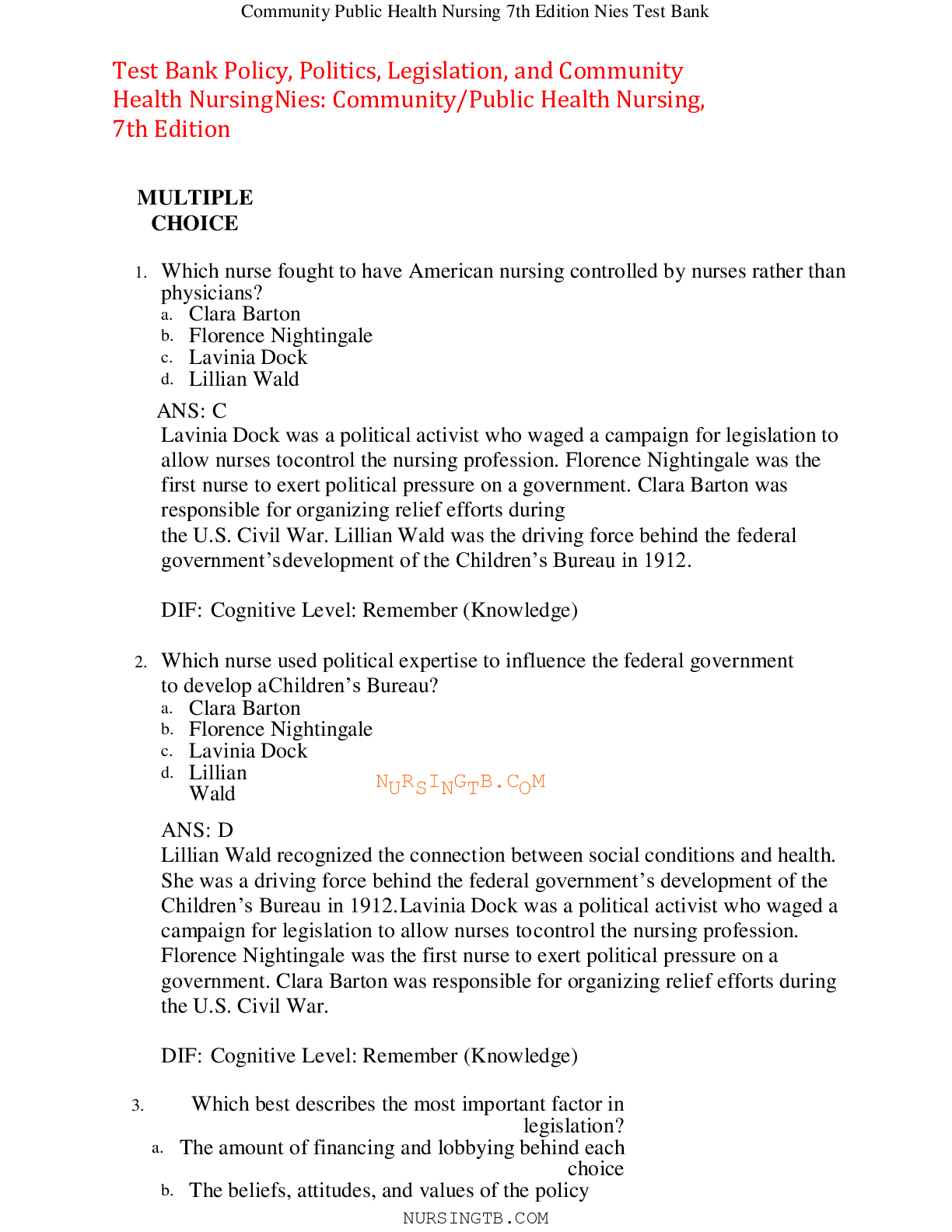


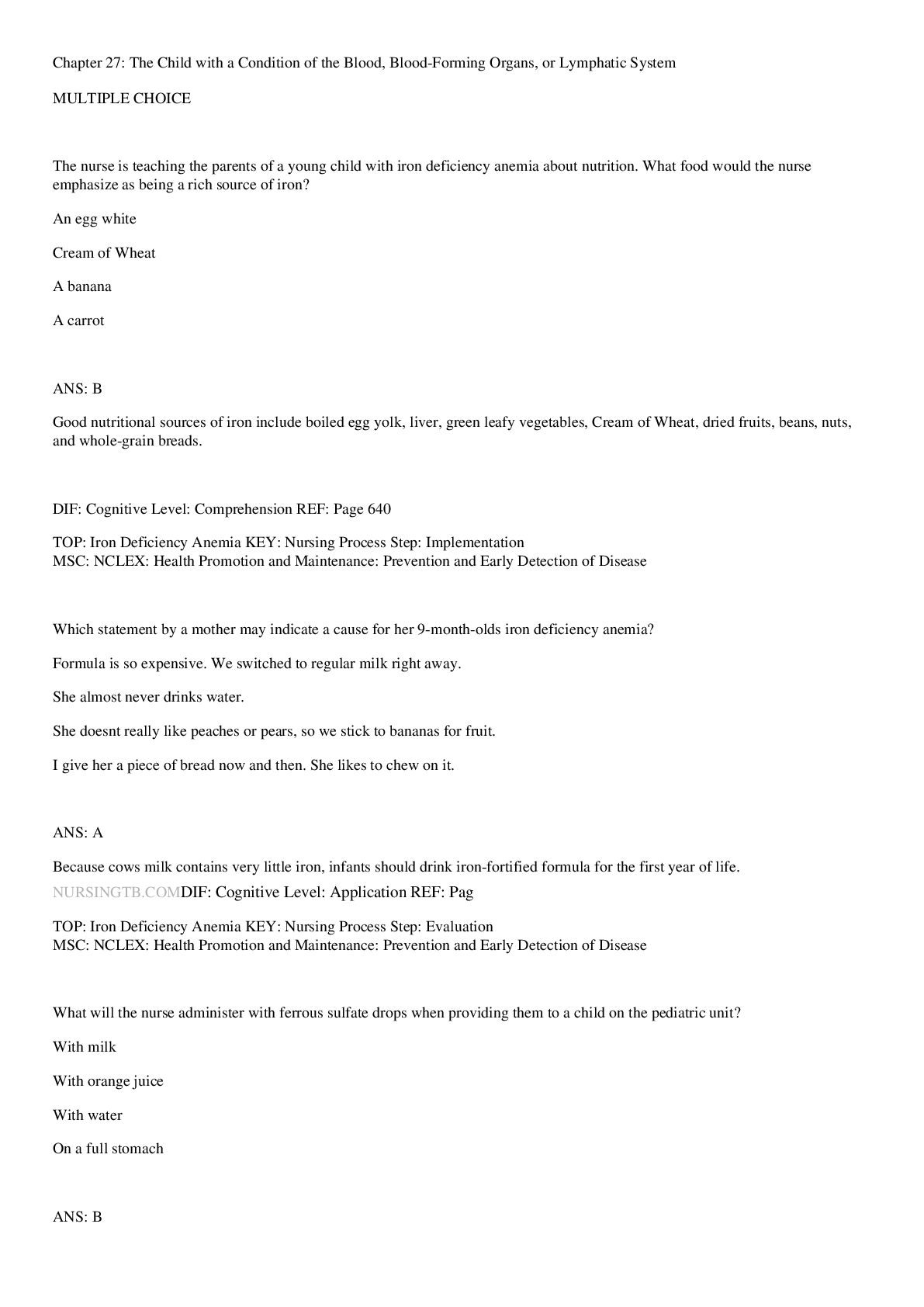



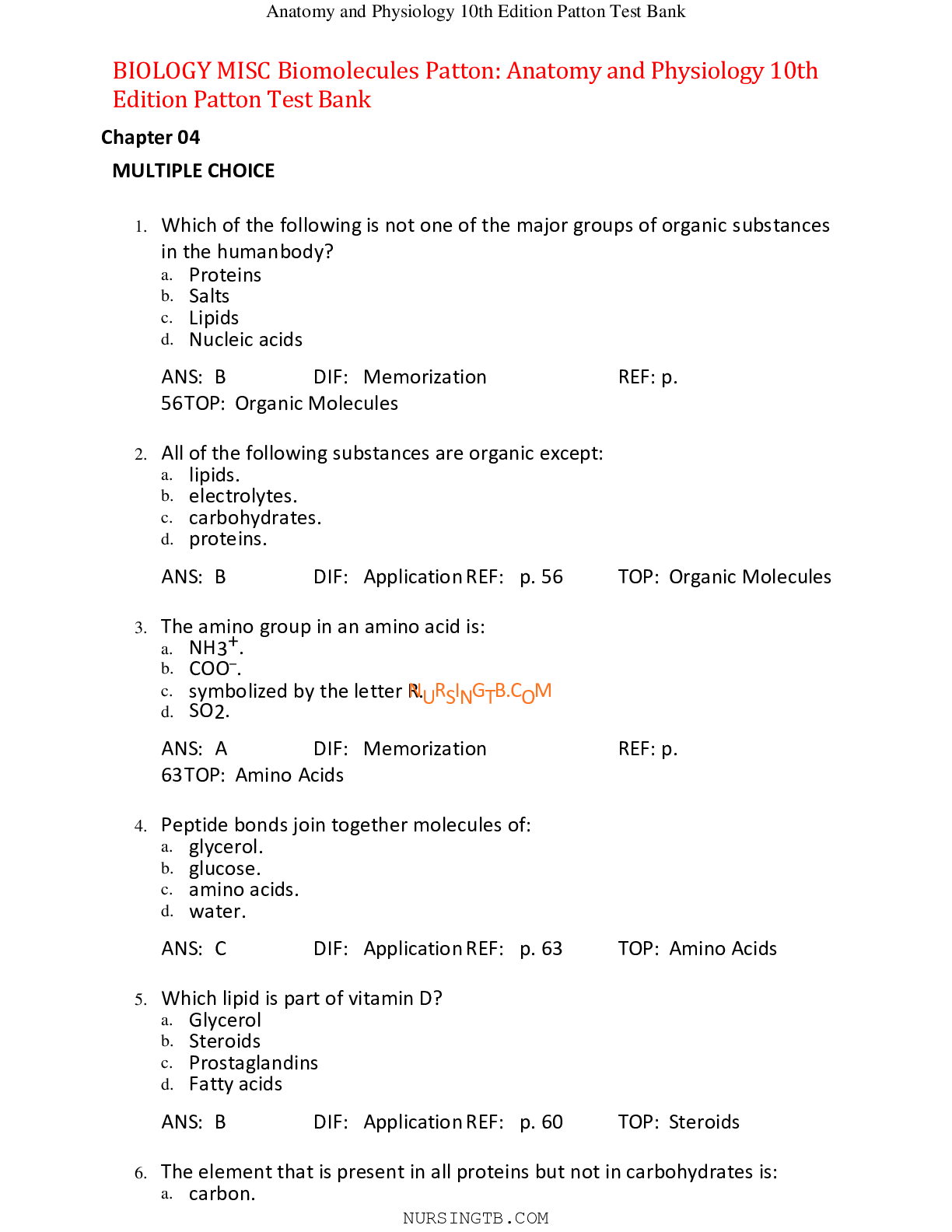







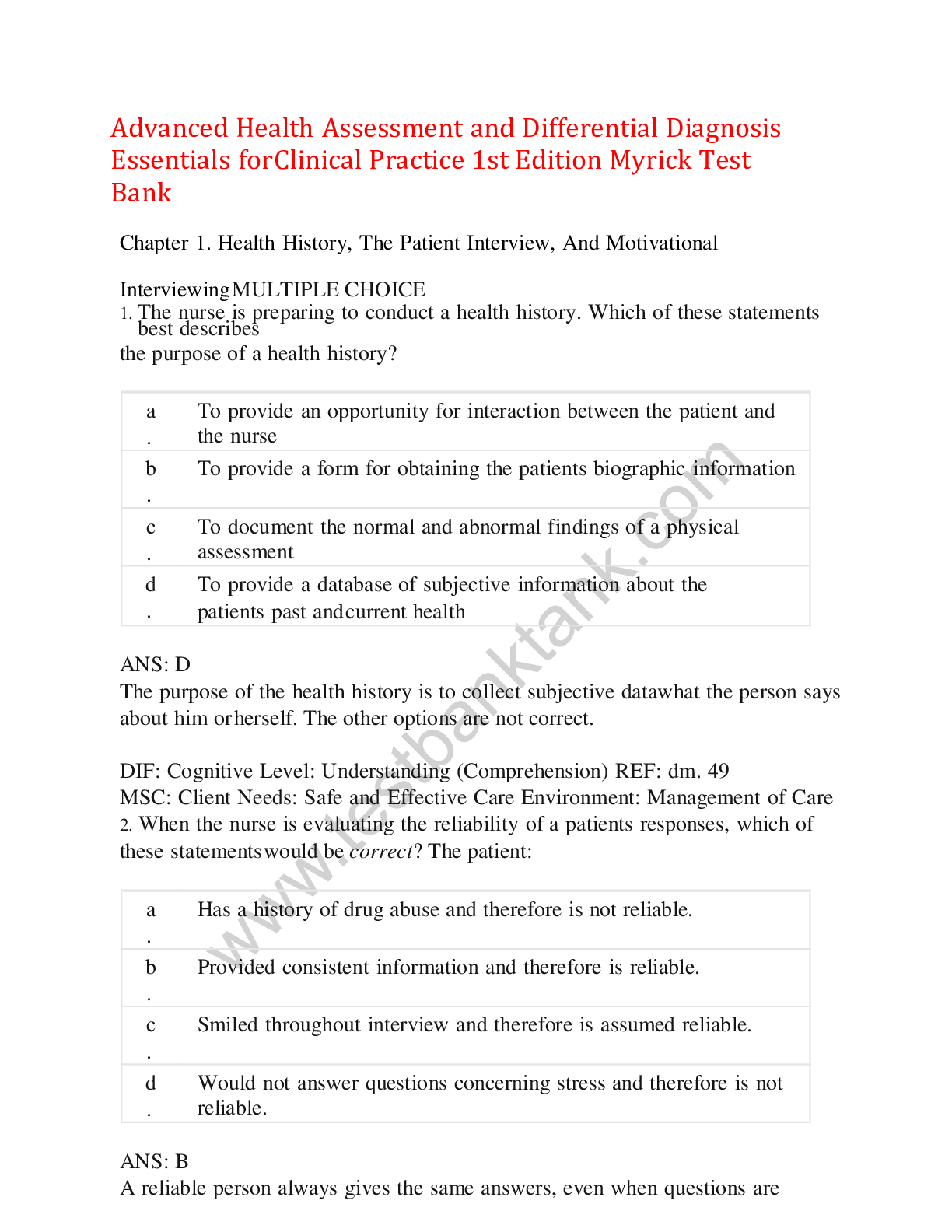

.png)
